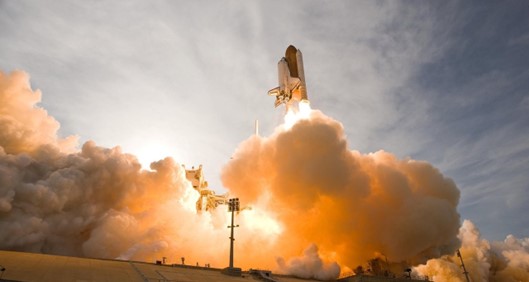

Electric Propulsion with Krypton Is Out of This World
Gases / Industries / Insights
It’s been said that electric propulsion (EP) is the future of astronautics. Electric Propulsion (EP) is a class of space propulsion which uses electrical power to accelerate a propellant by different electrical and/or magnetic resources. Unlike chemical systems, electric propulsion requires very little mass to accelerate a spacecraft. The propellant is ejected up to twenty times faster than from a chemical thruster, making the overall system much more efficient. Electric propulsion is routinely used for orbit raising and station keeping of satellites and has enabled several scientific missions. Xenon had been used as the propellant for electric propulsion for many years, but more cost-effective krypton has been adopted on a large scale recently.
Why Krypton?
Krypton (Kr) is referred to as a rare gas, as it makes up 1ppm of the earth’s atmosphere. Along with its counterparts, xenon and neon, krypton is produced in the same cryogenic separation and purification process that produces oxygen, nitrogen, and argon, but in much smaller quantities. The rare gas was discovered by Scottish and English chemists, Sir William Ramsay and Morris Travers in 1898, filling in the inert gases on the periodic table. Like the mythical space-rock that diffuses superpowers, krypton lights up blue-green, and even smoky white when conducted under an electrical current.
As a propellant, krypton is a seamless alternative to xenon. Krypton and xenon belong to the same inert gas group in the periodic table and exhibit similar chemical properties. Krypton is more widely available on Earth (the amount is approximately 10X more than xenon), and its price is less than one-tenth. Low-earth orbit (LEO) satellites have extensively used krypton-propellant Hall thrusters as propulsion devices. Krypton is the most used alternative propellant in electric propulsion applications.
Electric Propulsion
An electric propulsion system uses either solar energy (solar electric propulsion) or a nuclear reactor (nuclear electric propulsion) to generate thrust. That power is then converted and used to positively charge (ionize) inert gas propellants like krypton. A combination of electric and magnetic fields or an electrostatic field then accelerates the ions and forces them out of the thruster, pushing the spacecraft. Electric propulsion is ideal for long duration space flights, such as satellites, as it has little thrust but can be sustained at tremendous speeds over time.
Krypton and Rare Gas Supplier in the Rocky Mountain Region
Rocky Mountain Air Solutions is a supplier of rare gases, including krypton, serving industries within the Rocky Mountain region (Colorado, Utah, Wyoming, Idaho, Nebraska). Rocky Mountain Air offers both high-purity cylinders and mixtures to serve a multitude of industries, from lighting and photography to medical applications and scientific research. Krypton cylinders may be purchased on their own, or in rare gas mixtures.
We also supply neon and xenon to the Rocky Mountain region. Though neon, krypton, and xenon have similar uses in some industries, the chemical properties and costs vary. We are happy to discuss your needs and suggest the best gas for your application. If you are interested in partnering with RMA as your rare gas supplier, please contact your local branch to speak to a representative today. We look forward to serving you with flawless dependability!



